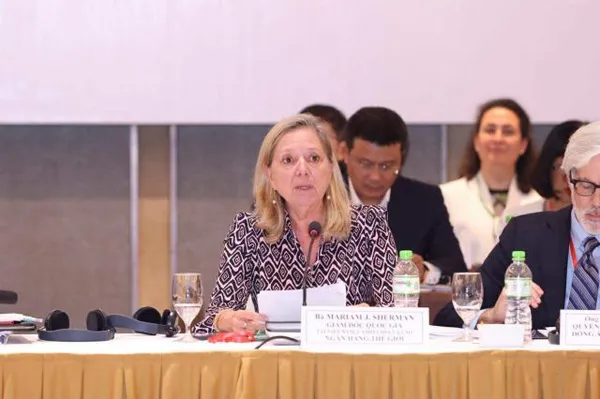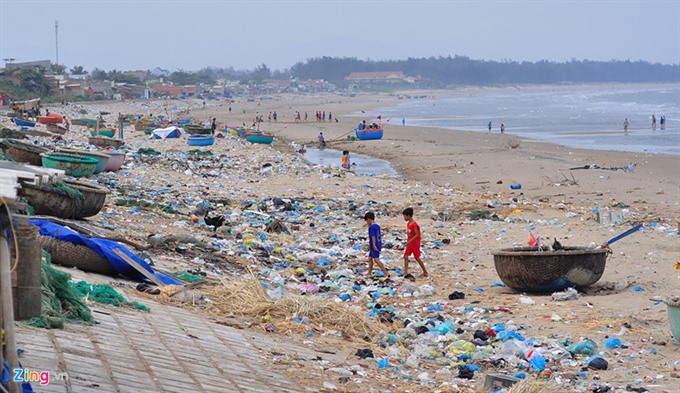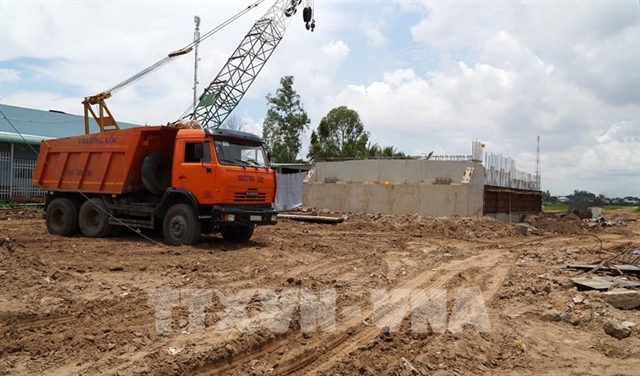 Op-Ed
Op-Ed

Years of rapid economic development have left Việt Nam with negative externalities – noise and poor air quality arising from pollution and road congestion.
 |
| Solid waste discharges to Phan Rí Cửa beach, Tuy Phong District, Bình Thuận Province. — Photo zing.vn |
Thu Vân
Years of rapid economic development have left Việt Nam with negative externalities – noise and poor air quality arising from pollution and road congestion.
Pollution was once accepted as the inevitable by-product of industrial development and promoted as economic progress. After World War II, eager for any sort of industrial development, governor of the US’ state of Alabama, George Wallace, described the odour from a local paper mill as “the smell of prosperity”.
Public attitudes have changed significantly since then.
Clean air to breathe is now recognised by the United Nations and others as a universal human right, essential to physical well-being. In 2016, the World Health Organisation (WHO) labeled air pollution a global public health emergency.
It seems like we have too many emergencies here in Việt Nam.
Việt Nam now ranks among the 10 countries with the world’s worst air pollution.
Its biggest cities, including Hà Nội and HCM City, are reported to have dangerous levels of fine particulate matter.
Annual average air pollution in Hà Nội in 2017 was four times higher than that deemed acceptable by WHO’s air quality guidelines, according to a report by the Green Innovation and Development Centre.
Particularly, in 2017, Hà Nội had 99 days breaking the national red line and 257 days beyond international levels in terms of air quality.
Things didn’t get much better in 2018, when 91 per cent of days in Hà Nội saw excessive levels of PM2.5 in the first three months of the year.
The figure dropped by 41 days in the third quarter. But in the first days of 2019, air pollution became so severe that health experts had to warn people to stay indoors.
PM, or particulate matter, or particle pollution, is not something new. It’s a mixture of solid particles and liquid droplets found in the air we breathe. Overwhelming evidence shows that particle pollution is extremely harmful. It can increase the risk of heart disease, lung cancer, or seriously affect one’s intelligence and growth. One study last year also suggested that it could be linked to dementia. In short, it is deadly.
On some days in January, the PM2.5 concentration in Hà Nội was 400 micrograms per cubic metre on Phạm Văn Đồng Street while on Mỹ Đình Street was 300. The WHO safety limit is 25 micrograms per cubic metre.
The Ministry of Natural Resources and Environment said the main sources of air pollution are transportation, industrial production, construction, agricultural production and improper waste management.
When the PM2.5 level was at 150 in Thailand, the Thai government apologised to citizens in Bangkok about the air pollution that continues to threaten their health. They called on owners of diesel-fuelled vehicles to only use their cars when absolutely necessary, and promised a long-term solution to improve the integrated public-transportation system, fuel quality and exhaust fume standards. Authorities in Bangkok said they would hand out N95 masks that can protect people against PM2.5 dust.
Now, in an attempt to address its own pollution problem, Việt Nam has launched a national action programme to manage air pollution and improve air quality.
Hà Nội also approved a plan to ban motorcycles by 2030 and is working on a new train system to improve public transport. It has also planted more than 80 per cent of a target of a million trees and wants to add 80 monitoring stations over the next few years.
Maybe more can be done.
Installing monitoring stations will just identify the problem – it won’t solve it. And while we wait for the public transport system to be completed, millions of cars and motorbikes are still crowding the narrow streets of Hà Nội and HCM City. Old buses still discharge black smoke as they travel through the streets. Certification for emission standards is said to be expensive and can result in bribery.
On the other hand, Việt Nam relies heavily on coal to generate much of its power. Ngụy Thị Khanh from GreenID said coal-fired power plants are one of the major causes of worsening air pollution.
Hà Nội is surrounded by around 20 coal-fired plants in the northern region. Việt Nam build 26 coal power plants more from its post-2020 energy master plan.
According to the United State’s Energy Information Administration, burning coal produces emissions like sulphur dioxide, which contribute to acid rain and respiratory illnesses; nitrogen oxide, which contributes to smog and respiratory illnesses; particulates, which contribute to smog, haze and respiratory illnesses and lung disease; carbon dioxide, mercury and other heavy metals, fly ash and bottom ash, which have been linked to both neurological and developmental damage in humans.
Data from WHO shows that more than 60,000 deaths from heart disease, strokes, lung cancer, chronic obstructive pulmonary disease and pneumonia in Việt Nam in 2016 were linked to air pollution.
Hà Nội’s department of environment said the ratio of citizens that have pneumonia or have to be hospitalised for discomfort when breathing could be double by 2020 if the city does not have any means to reduce air pollution.
In an attempt to fight air pollution, Thailand has set up many large LCD screens around Bangkok showing pollution levels. London had an initiative to use data analytics, sensors and maps to provide their residents with a visual tool explaining their exposure to air pollution. South Korea launched a special law on fighting fine dust pollution this February, establishing the legal grounds for local governments to impose mandatory restrictions on coal power plants and other heavy emitters of dust particles.
Given the urgency and the seriousness of the air pollution situation, maybe it’s time the Vietnamese Government think of an action plan to clean up the air as a matter of urgency. It’s time they treat air pollution as a public health crisis and start telling people about it, warning them about it instead of telling people not to panic.
Build more air pollution monitoring stations across the country and make the data available to the public so that proper awareness about the problem is in place. Reduce the number of cars on the road. Require motorists to use environmentally-friendly fuel. Apply stricter enforcement on existing standards for factory pollution and construction sites. Tell schools to restrict outdoor play and exercise on days when the air quality is particularly poor. And maybe, Việt Nam will need just one coal power plant more instead of 26.
Of course, individuals can play a role too – we can reconsider our choices to drive, and walk or cycle instead. But we will need the Government to show their leadership with a way to fight this battle.
In the pursuit of sustainable development, the Government can also make their choices – either to encourage activities that make a positive contribution to the country’s progress, or accept the consequence that the environment and people have to suffer in order to catch up.
Industrialists in Victorian Britain saw the smoky streets of the Industrial Revolution as signs of wealth and progress. It’s not the same now. The old school yardstick of gross domestic product is deficient. We don’t want to pay too high price in exchange for economic development.
Even though Việt Nam might not have reached the level of its more polluted neighbours, that’s not something we should feel relieved about. If we don’t do anything quickly, the pollution crisis will become a form of capital punishment. — VNS




